If you are planning to buy a new motherboard, it is important to know what chipsets they come with. In this particular article, we compare two great Intel chipsets – Z590 vs Z690. These two chipsets come with a lot of features. So, before you choose a motherboard, make sure to get all the necessary information about its chipset.
Z590 vs Z690 – General Overview
These two Intel chipsets belong to two different Intel chipset series. Z590 belongs to the Intel® 500 Series, whereas Z690 belongs to the Intel® 600 Series. This basically means that the 600 series is more recent and has more advanced features.
The most significant differences between the two come down to PCIe lanes and support for different memory types. But let’s dive into a more detailed Z590 vs Z690 comparison.
Intel Z590

Pros:
- Wide selection of supported processors
- Supports overclocking
- High data transfer speed – 20 Gb/s
- Large RAM capacity
Cons:
- No support for DDR5
- Supports only PCIe 3.0
Intel Z690
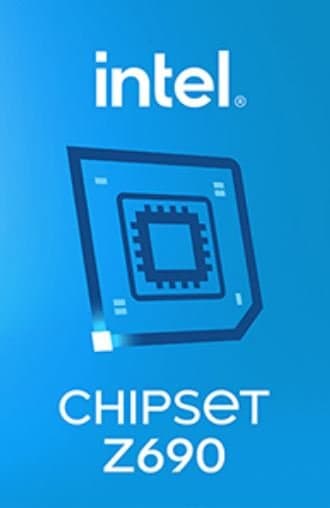
Pros:
- Supports DDR5
- PCIe 4.0 support plus PCIe 5.0 readiness
- Compatible with the latest Intel Core processors
- Lots of USB ports
Cons:
- Only one PCIe x16 slot
- More expensive
Socket and CPU Compatibility
Socket type supported
As you may already know, a CPU must be compatible with a motherboard. This means that the motherboard must have a suitable socket type to connect to a CPU.
The chipsets in our comparison support different socket types. So, Z590 supports the LGA 1200 socket, which is compatible with 11th and 10th Generation Intel Core Processors.
Z690 supports the LGA1700 socket, which is compatible with 12th Gen Intel Core desktop processors.
| Brand | Socket | CPU |
|---|---|---|
| Intel | LGA 1700 | 12th Gen Core |
| Intel | LGA 1200 | 11th and 10th Gen Core |
CPU support/compatibility
When you decide to get a new motherboard, remember that it needs to be compatible with your CPU. You need to identify your CPU model first. You can do that by completing the following steps: Press the Windows key, type in the word “system,” and click on “System Information.”
Once you confirm your CPU model, you need to find compatible motherboards. Check out the table below to see what CPUs are supported by the Z590 and Z690 chipsets.
| Z590 Compatible Processors | Z690 Compatible Processors |
|---|---|
| 11th Generation Intel Core i9 Processors | 12th Generation Intel Core i9 Processors |
| 10th Generation Intel Core i9 Processors | 12th Generation Intel Core i7 Processors |
| 11th Generation Intel Core i7 Processors | 12th Generation Intel Core i5 Processors |
| 10th Generation Intel Core i7 Processors | 12th Generation Intel Core i3 Processors |
| 11th Generation Intel Core i5 Processors | Intel Pentium Gold Processor Series |
| 10th Generation Intel Core i5 Processors | Intel Celeron Processor G Series |
| 10th Generation Intel Core i3 Processors | |
| Intel Pentium Gold Processor Series |
As you can see, both chipsets support processors from the Core family, but different generations of those processors. However, they both support the Gold Processor series. Additionally, Z690 supports the Celeron G series.
Even though Z590 supports more generations of processors, Z690 supports the latest generation of Core processors.
So which chipset is better? It all depends on which generation of processor you already own. If you want to learn more about the Core CPU generation, you can read our comparison of popular Intel Core processors.
Form Factor
There are three main form factors regarding motherboards — ATX, Micro ATX, and Mini ITX. Each of these terms represents a motherboard’s size, shape, and design.
ATX motherboards are the biggest and the best choice for overclocking or running multiple graphics cards. Since they are big, they consequently need more space. Therefore, you would need to invest in a Mid or Full Tower case.
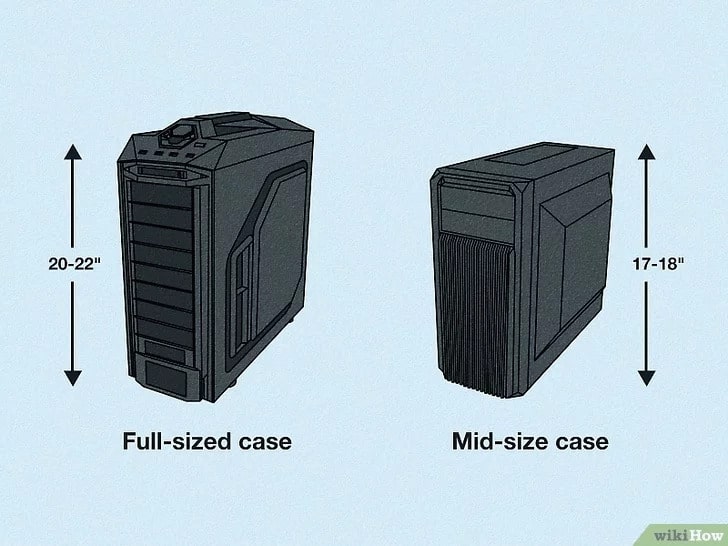
Micro ATX motherboards are smaller than ATX motherboards, but they are the best for single-GPU use. Mini ITX is the smallest form factor, but it comes at the cost of lesser slots. They only have one PCI-e and two RAM slots.
| Z590 Motherboards | Form Factor | More Info |
|---|---|---|
| Gigabyte Z590 Aorus Elite AX | ATX | Check Price on Amazon |
| ROG Strix Z590-I Gaming Wi-Fi | Mini ITX | Check Price on Amazon |
In general, most Z590 motherboards are of the ATX variety, but they also come in Mini ITX and Micro ATX form factors.
| Z690 Motherboards | Form Factor | More Info |
|---|---|---|
| ASUS ROG Strix Z690-F Gaming Wi-Fi | ATX | Check Price on Amazon |
| MSI PRO Z690-A Wi-Fi | ATX | Check Price on Amazon |
GPU Compatibility
SLI / Crossfire compatibility?
These two terms represent the same technology; Nvidia and Crossfire developed SLI by AMD . These technologies basically allow you to use multiple graphics cards on one motherboard. This can help you enhance performance a bit.
When it comes to the Z590 and Z690, some motherboards support either one or both technologies. However, if this is important to you, you should check the support information for the motherboard you plan to buy.
For example, MSI MEG Z590 GODLIKE Gaming Motherboard and MSI MEG Z690 GODLIKE EATX support both SLI and Crossfire technology.
Performance
Overclocking
A manufacturer sets a clock speed (operating speed of a computer) limit for every computer component they make. The good news is that you have the option to increase that speed limit. Overclocking allows you to raise the component’s speed above its set limit.
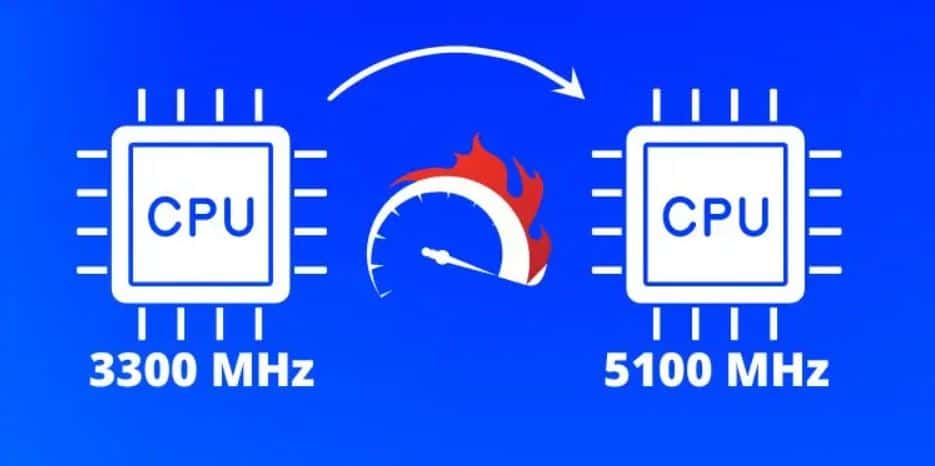
Overclocking on motherboards is easier since they usually come with overclocking tools. But you don’t just need a good tool for overclocking — both the motherboard and the component need to be unlocked for overclocking.
Both chipsets in our Z590 vs Z690 comparison support overclocking. So, you can’t go wrong with either of these chipsets if overclocking is a critical feature for you.
The downside to overclocking is that it increases heat and power consumption. There are some things you can do to lower your motherboard temperature. You need to have a good cooling system set in place and clean the dust and dirt regularly.
If you want to combine aesthetics and usefulness, you should consider installing one of Corsair’s RGB fans.
Data transfer speed
One of the main features of any motherboard is the number of USB ports. Additionally, you should also pay attention to the USB port types, as different USB generations have different transfer speeds.
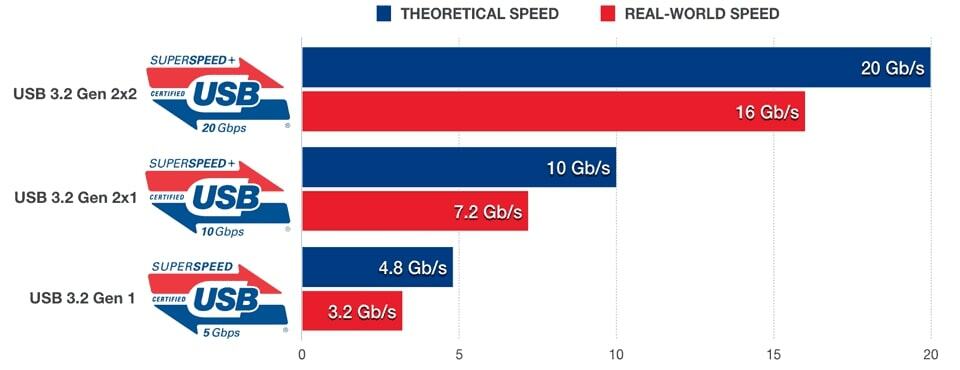
Today, the range of USB transfer speeds goes from 480 Mb/s to 20 Gb/s, with the latest USB types offering the highest speeds.
| Chipset | 2.0 | 3.2 Gen 1×1 | 3.2 Gen 2×1 | 3.2 Gen 2×2 | Total number of USB ports |
|---|---|---|---|---|---|
| Z590 | 14 ports | Up to 10 ports | Up to 10 ports | Up to 3 ports | 14 |
| Z690 | 14 ports | Up to 10 ports | Up to 10 ports | Up to 4 ports | 14 |
As shown in the table above, Z590 and Z690 chipsets support everything from USB 2.0 to USB 3.2 2×2 types. Since they both support USB 3.2 Gen 2×2, the data transfer speed can go up to 20 Gb/s.
However, Z690 motherboards usually come with up to four USB 3.2 Gen 2×2 ports, one more than Z590 motherboards. Therefore, they are a slightly better choice when it comes to USB ports.
Memory speed and compatibility
Z590 and Z690 motherboards usually come with a maximum capacity of 128 GB of RAM. They both support two DIMMs per channel.
| Memory Speed & Capacity | Z590 | Z690 |
|---|---|---|
| Maximum Speed | 3200 MHz | 4800 MT/s |
| Maximum Capacity | 128 GB | 128 GB |
However, there is a significant difference in the maximum speed and memory type they support. Z590 supports DDR4 memory type and speeds up to 3200 MHz.
In comparison, the Z690 chipset supports both DDR4 and DDR5. DDR4 can reach speeds of up to 3200 MT/s, and DDR5 goes up to 4800 MT/s. Find out the difference between MT/s and MHz.
Other Features
Wi-Fi compatibility
The good news is that both of these motherboards support Wi-Fi. The Z590 chipset supports Wi-Fi 6 AX201(Gig+), while the Z690 supports Wi-Fi 6E AX211(Gig+).
Again, we recommend you check each motherboard’s specifications to confirm they support Wi-Fi.
Connectivity options
In terms of connectivity, these chipsets are similar. Let’s see how they compare in this segment.
| Connectivity Options | Z590 | Z690 |
|---|---|---|
| Number of USB ports | 14 | 14 |
| Transfer Speed | Up to 20 Gb/s | Up to 20 Gb/s |
| SATA 6.0 Gb/s Ports | 6 | 8 |
| PCI Express Lanes | 24 | 28 |
As we mentioned earlier, these chipsets are identical regarding USB connectivity, as each of them supports up to 14 USB ports.
However, the Z690 chipset has eight SATA ports, two more than the Z590 chip. On the other hand, the biggest difference is in the PCI Express lanes. Z590 has 24 lanes which allow a speed of 8 Gb/s each. It supports only PSI Express 3.0.
The Z690 chipset has 28 lanes in total and up to 16 PCI Express 3.0 lanes with a speed of 8 Gb/s each. It also supports PCI Express 4.0. It has up to 12 PCI Express 4.0 lines that support a speed of up to 16 Gb/s.
BIOS
In most cases, you will need to update the BIOS to run the processor on your Z590 or Z690 motherboard. So, visit the official website of your motherboard to download and install BIOS updates.
Future-proofing
Future-proofing comes down to the question of whether you will be able to use your motherboard in the long run or not. So, you need a lot of different ports and slots that support fast speeds.
Regarding future-proofing, the Z690 chip is superior to the Z590. It not only supports PCIe 4.0, which is faster than PCIe 3.0, but it also supports the DDR5 memory type. It is also compatible with the latest generation of Intel processors.
If you are building a computer to use in the long run, Z690 might be a far better choice.
Recommended Z590 Motherboards
ROG Strix Z590-E Gaming Motherboard
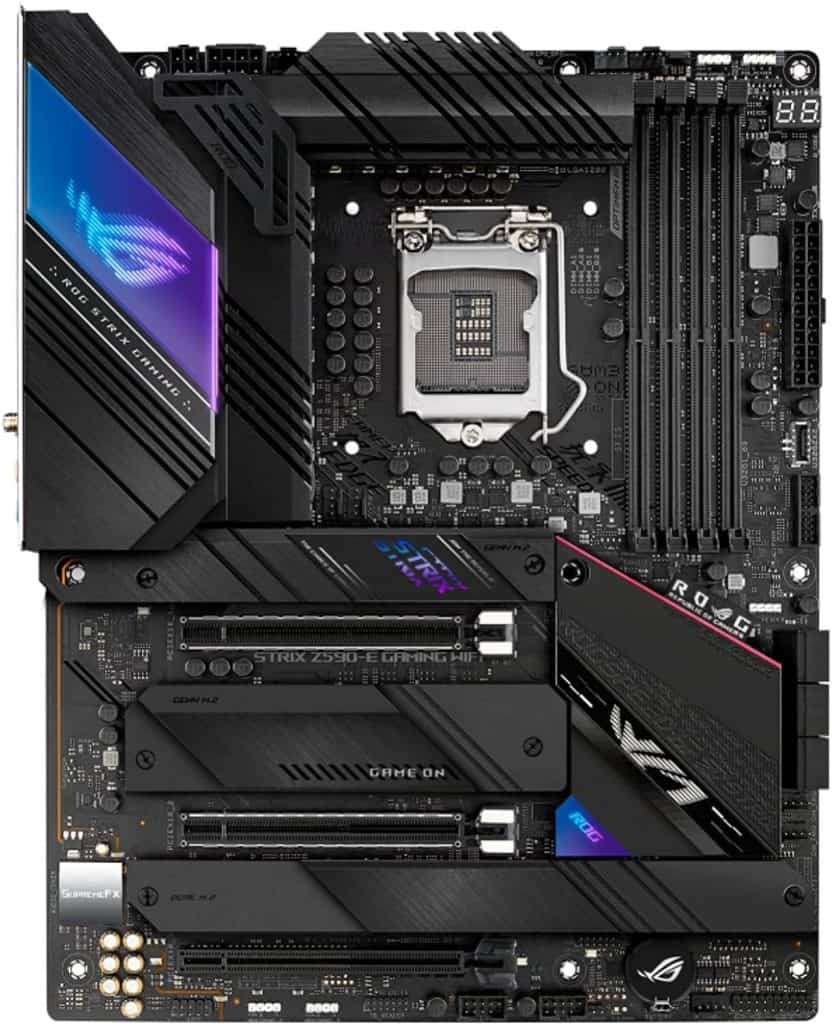
The ROG Strix Z590-E Gaming motherboard supports both Crossfire and SLI technology. So, this unit is a good choice if you want to use this technology. It supports DDR4 up to 128 GB RAM.
| Features | ASUS ROG Strix Z590-E Gaming |
|---|---|
| Socket Type | LGA 1200 |
| CPU | 11th and 10th Gen Intel Core Series Processors |
| BIOS Update | Supported |
| Form Factor | ATX |
| SLI / Crossfire | Crossfire and SLI |
| Overclocking | Yes |
| Memory Type | DDR4 |
| Max Memory Capacity | 128 GB (4 slots) |
| Data Transfer Speed | USB 3.2 Gen2X2 |
Recommended Z690 Motherboard
GIGABYTE Z690 AORUS MASTER
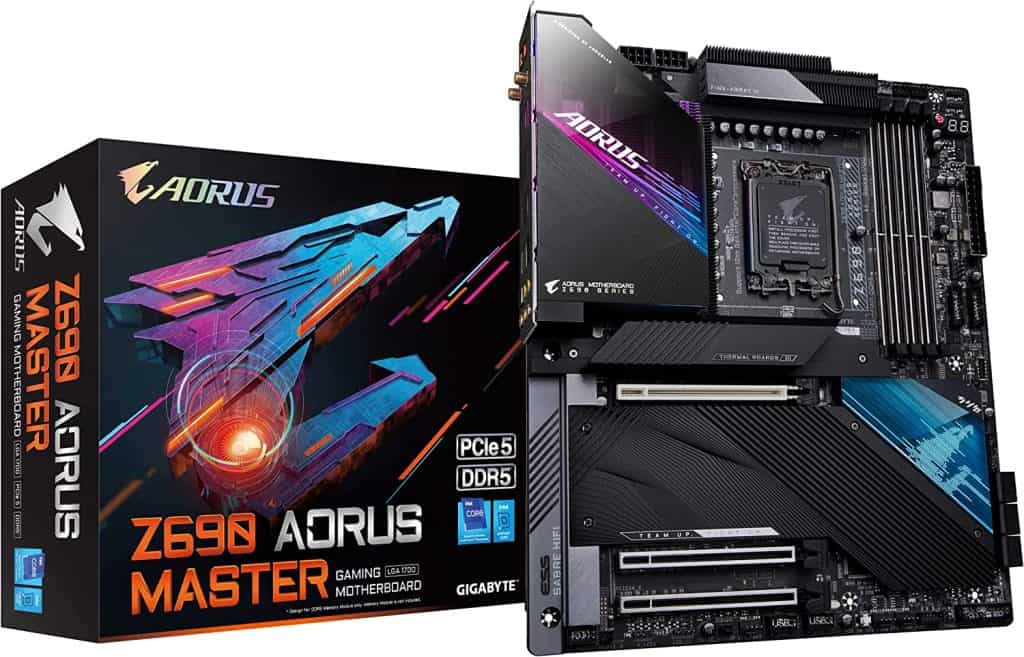
GIGABYTE Z690 AORUS MASTER is one of the best Z690 motherboards on the market. It supports the 12th generation of Intel Core processors. It also supports Crossfire technology. And most importantly, it supports DDR5 memory!
| Features | GIGABYTE Z690 AORUS MASTER |
|---|---|
| Socket Type | LGA 1700 |
| CPU | 12th Gen Intel Core Series Processors |
| BIOS Update | Supported |
| Form Factor | ATX |
| SLI / Crossfire | Crossfire only |
| Overclocking | Yes |
| Memory Type | DDR5 |
| Max Memory Capacity | 128 GB (4 slots) |
| Data Transfer Speed | USB 3.2 Gen2X2 |
Conclusion
So, which one to choose from this Z590 vs Z690 comparison? It depends on whether you really need the extra perks the Z690 offers.
If you are unwilling to pay extra, you can purchase a Z590 motherboard and get decent performance. You can still have fast RAM and upgrade up to 128 GB. The 10th and 11th generations of processors are not exactly outdated. Additionally, you get fast USB transfer speeds thanks to the USB 3.2 Gen 2×2 ports.
However, if you want to get the latest generation of Intel Core processors and combine it with DDR5 RAM, Z690 is a better choice. If future-proofing is your thing, and you don’t mind investing a little bit more, then the Z690 motherboard is the way to go.